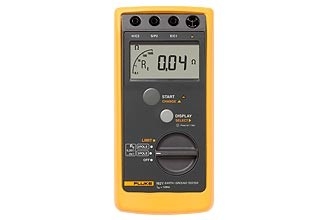Fluke 1621 Earth Ground Tester
Earth Ground Tester for resistance measurement
The Fluke 1621 is an easy-to-use earth ground tester. For ground resistance testing, the 1621 is the first line of defense in detecting reliable ground connections. The unit features basic ground testing methods including 3-pole Fall-of-Potential as well as 2-pole ground resistance tests. Its convenient size, rugged holster, and large, clear LCD display make it an ideal field earth ground tester, for most electrical grounding work environments. With a simple user interface and intuitive functionality, the Fluke 1621 is a handy grounding tool for electrical contractors, utility test engineers, and earth ground specialists.
| General specifications | |||||||||
| Measuring functions |
|
||||||||
| Intrinsic error |
|
||||||||
| Measuring rate |
|
||||||||
| Battery[1] |
|
||||||||
| Battery condition |
|
||||||||
| Voltages |
|
||||||||
| Climatic class |
|
||||||||
| Temperature performance[2] |
|
||||||||
| Temperature coefficient |
|
||||||||
| Safety |
|
||||||||
| Dimensions |
|
||||||||
| Weight |
|
||||||||
| Note: |
|
||||||||
| Note: |
|
||||||||
| Electrical specifications | |||||||||||||||||||||
| Maximum deviations: |
|
||||||||||||||||||||
| Test voltage |
|
||||||||||||||||||||
| Protection type |
|
||||||||||||||||||||
| Electromagnetic compatibility |
|
||||||||||||||||||||
| RE resistance measurement |
|
||||||||||||||||||||
| Measuring time |
|
||||||||||||||||||||
| Limit input |
|
||||||||||||||||||||
| Automatic changeover of resolution |
|
||||||||||||||||||||
| Interference voltage display dc + ac |
|
||||||||||||||||||||
| Measuring range | |||||
| 0.15 Ω to 20 Ω |
|
||||
| 200 Ω |
|
||||
| 2 kΩ |
|
||||
| Intrinsic uncertainty |
|
||||
| Operating uncertainty IEC 61557[1] |
|
||||
| Notes: |
|
||||
 |
|
Sorry, Currently No Video Uploaded.
Sorry, Currently No File Uploaded.
Fluke 1621 Earth Ground Tester
Please Leave Your Product Enquiry Here. We will Get Back To You Soon.
Product Specifications
- Product SKU : -
- Weight (GRAM) : -
- Dimension : -
Related Products
Locate Us
Mobicon - Remote Electronic Pte Ltd






